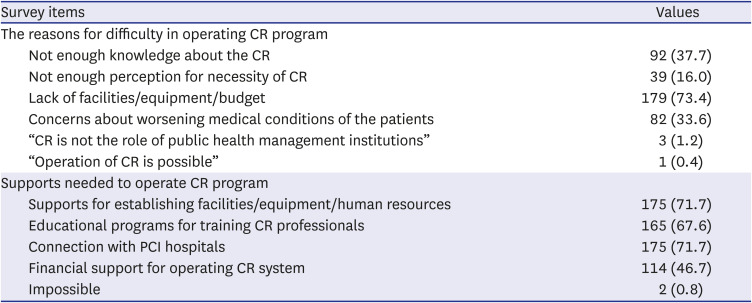3. Arnett DK, Blumenthal RS, Albert MA, Buroker AB, Goldberger ZD, Hahn EJ, et al. 2019 ACC/AHA guideline on the primary prevention of cardiovascular disease: a Report of the American College of Cardiology/American Heart Association task force on clinical practice guidelines. Circulation. 2019; 140(11):e596–e646. PMID:
30879355.
4. Anderson L, Thompson DR, Oldridge N, Zwisler AD, Rees K, Martin N, et al. Exercise-based cardiac rehabilitation for coronary heart disease. Cochrane Database Syst Rev. 2016; (1):CD001800. PMID:
26730878.

5. Ades PA, Keteyian SJ, Balady GJ, Houston-Miller N, Kitzman DW, Mancini DM, et al. Cardiac rehabilitation exercise and self-care for chronic heart failure. JACC Heart Fail. 2013; 1(6):540–547. PMID:
24622007.

6. Bethell HJ. Cardiac rehabilitation: from Hellerstein to the millennium. Int J Clin Pract. 2000; 54(2):92–97. PMID:
10824363.
7. Fang J, Ayala C, Luncheon C, Ritchey M, Loustalot F. Use of outpatient cardiac rehabilitation among heart attack survivors - 20 states and the district of Columbia, 2013 and four states, 2015. MMWR Morb Mortal Wkly Rep. 2017; 66(33):869–873. PMID:
28837549.

8. Park LG, Schopfer DW, Zhang N, Shen H, Whooley MA. Participation in cardiac rehabilitation among patients with heart failure. J Card Fail. 2017; 23(5):427–431. PMID:
28232047.

9. Ades PA, Keteyian SJ, Wright JS, Hamm LF, Lui K, Newlin K, et al. Increasing cardiac rehabilitation participation from 20% to 70%: a road map from the million hearts cardiac rehabilitation collaborative. Mayo Clin Proc. 2017; 92(2):234–242. PMID:
27855953.

10. Kim SH, Ro JS, Kim Y, Leigh JH, Kim WS. Underutilization of hospital-based cardiac rehabilitation after acute myocardial infarction in Korea. J Korean Med Sci. 2020; 35(30):e262. PMID:
32743992.

11. Shanmugasegaram S, Gagliese L, Oh P, Stewart DE, Brister SJ, Chan V, et al. Psychometric validation of the cardiac rehabilitation barriers scale. Clin Rehabil. 2012; 26(2):152–164. PMID:
21937522.

12. Baek S, Park HW, Lee Y, Grace SL, Kim WS. Translation, cross-cultural adaptation and psychometric validation of the Korean-language cardiac rehabilitation barriers scale (CRBS-K). Ann Rehabil Med. 2017; 41(5):858–867. PMID:
29201826.

13. Hutchinson K. Community-based cardiac rehabilitation: a YMCA model. ACSM’s Health Fit J. 2006; 10(6):21–27.
15. Hammill BG, Curtis LH, Schulman KA, Whellan DJ. Relationship between cardiac rehabilitation and long-term risks of death and myocardial infarction among elderly Medicare beneficiaries. Circulation. 2010; 121(1):63–70. PMID:
20026778.

16. JCS Joint Working Group. Guidelines for rehabilitation in patients with cardiovascular disease (JCS 2012). Circ J. 2014; 78(8):2022–2093. PMID:
25047729.
17. Kim C, Sung J, Han JY, Jee S, Lee JW, Lee JH, et al. Current status of cardiac rehabilitation in the regional cardiocerebrovascular centers in Korea. J Clin Med. 2021; 10(21):5079. PMID:
34768598.

18. Kim C, Sung J, Lee JH, Kim WS, Lee GJ, Jee S, et al. Clinical practice guideline for cardiac rehabilitation in Korea. Ann Rehabil Med. 2019; 43(3):355–443. PMID:
31311260.

19. Kim C, Sung J, Lee JH, Kim WS, Lee GJ, Jee S, et al. Clinical practice guideline for cardiac rehabilitation in Korea: recommendations for cardiac rehabilitation and secondary prevention after acute coronary syndrome. Korean Circ J. 2019; 49(11):1066–1111. PMID:
31646772.

20. Kim C, Sung J, Lee JH, Kim WS, Lee GJ, Jee S, et al. Clinical practice guideline for cardiac rehabilitation in Korea. Korean J Thorac Cardiovasc Surg. 2019; 52(4):248–285. PMID:
31404368.

21. Kim C. Overview of cardiac rehabilitation and current situations in Korea. Ann Cardiopulm Rehabil. 2021; 1(1):6–16.

22. Turk-Adawi K, Supervia M, Lopez-Jimenez F, Pesah E, Ding R, Britto RR, et al. Cardiac rehabilitation availability and density around the globe. EClinicalMedicine. 2019; 13:31–45. PMID:
31517261.
23. Goto Y. Current state of cardiac rehabilitation in Japan. Prog Cardiovasc Dis. 2014; 56(5):557–562. PMID:
24607022.

25. Balady GJ, Ades PA, Bittner VA, Franklin BA, Gordon NF, Thomas RJ, et al. Referral, enrollment, and delivery of cardiac rehabilitation/secondary prevention programs at clinical centers and beyond: a presidential advisory from the American Heart Association. Circulation. 2011; 124(25):2951–2960. PMID:
22082676.

26. Baek S, Ha Y, Mok J, Park HW, Son HR, Jin MS. Community-based cardiac rehabilitation conducted in a public health center in South Korea: a preliminary study. Ann Rehabil Med. 2020; 44(6):481–492. PMID:
33440096.

27. Clark RA, Conway A, Poulsen V, Keech W, Tirimacco R, Tideman P. Alternative models of cardiac rehabilitation: a systematic review. Eur J Prev Cardiol. 2015; 22(1):35–74. PMID:
23943649.

28. Shields GE, Wells A, Doherty P, Heagerty A, Buck D, Davies LM. Cost-effectiveness of cardiac rehabilitation: a systematic review. Heart. 2018; 104(17):1403–1410. PMID:
29654096.

29. Grace SL, Bennett S, Ardern CI, Clark AM. Cardiac rehabilitation series: Canada. Prog Cardiovasc Dis. 2014; 56(5):530–535. PMID:
24607018.











 PDF
PDF Citation
Citation Print
Print




 XML Download
XML Download